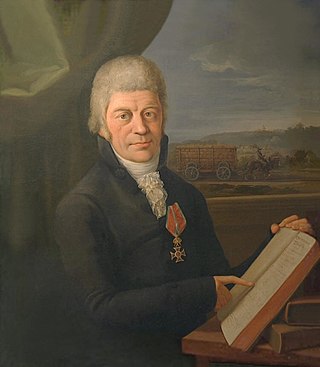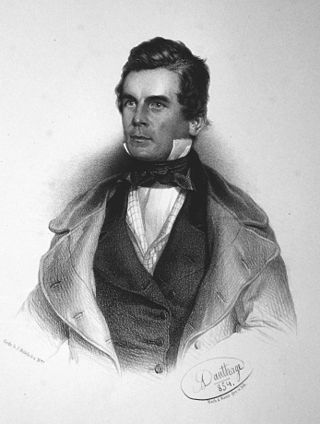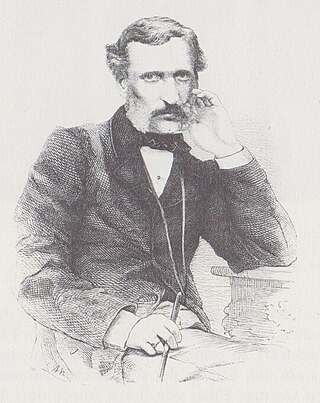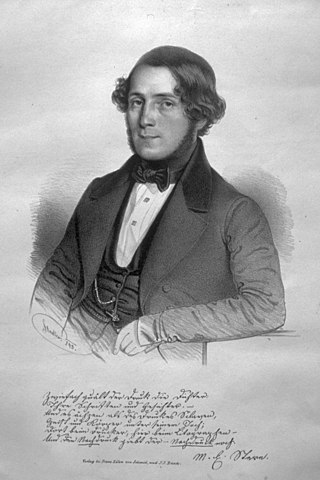
Nikolaus Alois Maria Vinzenz Negrelli, Ritter von Moldelbe was a Tyrolean civil engineer and railroad pioneer mostly active in parts of the Austrian Empire, Switzerland, Germany and Italy.

Konstantin Josef Jireček was an Austro-Hungarian Czech historian, politician, diplomat, and Slavist. He was the founder of Bohemian Balkanology and Byzantine studies, and wrote extensively on Bulgarian and Serbian history. Jireček was also a minister in the government of the Principality of Bulgaria for a couple of years.

Baron Carl von Rokitansky was an Austrian physician, pathologist, humanist philosopher and liberal politician, founder of the Viennese School of Medicine of the 19th century. Founder of science-based diagnostics.

Franz Josef Gerstner was a German-Bohemian physicist, astronomer and engineer.

Lőwy Hevesi Lajos, or Ludwig Hevesi was a Hungarian journalist and writer.

The Imperial-Royal State Railways abbr. kkStB) or Imperial-Royal Austrian State Railways was the state railway organisation in the Cisleithanian (Austrian) part of the Austro-Hungarian Monarchy.

Mathias Ritter von Schönerer was an Austrian engineer. He was one of the most important railway pioneers in Austria. He built the Südrampe or South Ramp on the Budweis–Linz–Gmunden Horse-Drawn Railway and its extension to Gmunden by the Traunsee lake. Following that, he was responsible for the construction of the Austrian Southern Railway or Südbahn from Vienna to Gloggnitz.

Anton Ritter Jaksch von Wartenhorst was an Austrian-Czech physician. He was the father of internist Rudolf von Jaksch (1855–1947).

Josef Redtenbacher was an Austrian chemist born in Kirchdorf an der Krems, Upper Austria. He was a brother to entomologist Ludwig Redtenbacher (1814–1876).

Josef Danhauser was a painter from the Austrian Empire. He was one of the prominent artists of Biedermeier period, along with Ferdinand Georg Waldmüller, Peter Fendi, and others. Danhauser's works, which went largely unappreciated in his time, dealt with moralising subjects and had a clear influence of William Hogarth.

Julius Alwin Franz Georg Andreas Ritter von Schlosser was an Austrian art historian and an important member of the Vienna School of Art History. According to Ernst Gombrich, he was "One of the most distinguished personalities of art history".
Anton Drasche was an Austrian internist and epidemiologist.

Hermann von Gilm, officially Hermann Gilm von Rosenegg was an Austrian lawyer and poet.

Karl Heinrich Seibt was a pioneering German catholic theologian and teacher.

Alexandrine von Schönerer née Lucia was an Austrian theater owner, managing director and actress.

Franz Ignaz von Holbein was an Austrian playwright and theatre director.

The Spielfeld–Trieste railway is a double-track, electrified main line in parts of Austria, Slovenia and Italy. It was built as a section of the Austrian Southern Railway by the state-owned k.k. Südliche Staatsbahn and from 1858 onward operated for decades by the Austrian Southern Railway Company (Südbahngesellschaft), a large private railway company in the Austrian Empire and Austria-Hungary. It runs from Spielfeld-Straß over the Austrian-Slovenian border at the Municipality of Šentilj, continuing via Maribor, Ljubljana and the Slovenian karst to the Adriatic port of Trieste, today in Italy. It continues from Spielfeld-Straß to Vienna as the Southern Railway nowadays.

The Budweis-Linz-Gmunden Horse-Drawn Railway was the second public railway line to be opened in mainland Europe. It opened in stages between 1827 and 1836, and principally served the transport of salt from the Upper Austrian Salzkammergut to Bohemia.

Max Emanuel Stern, also known as Mendel b'ri Stern, was a Hungarian-born Hebraist, writer, poet, and translator.

Josef Redtenbacher was an Austrian entomologist and teacher. He specialized in the orders of Orthoptera, Phasmatodea, Mantodea (mantis) and Blattodea (cockroaches), which are classically summarized as Orthoptera, as well as in the earwigs (Dermaptera), which are not assigned to the Orthoptera, especially from Austria-Hungary and Germany.






















